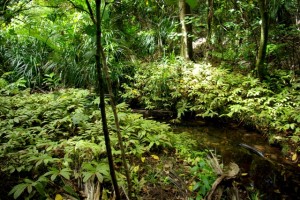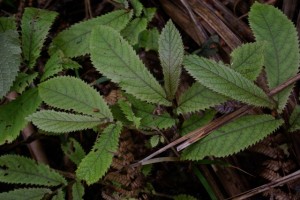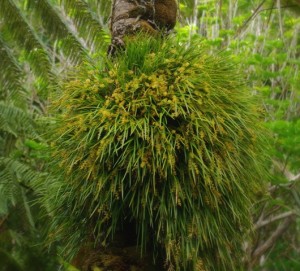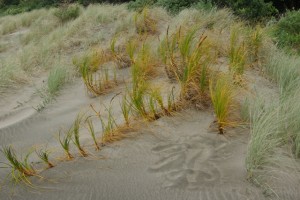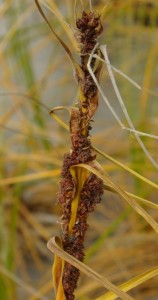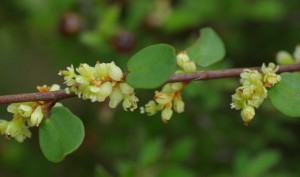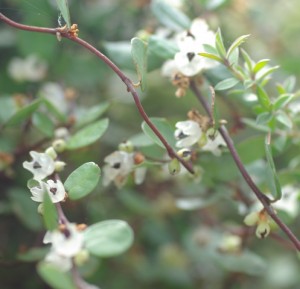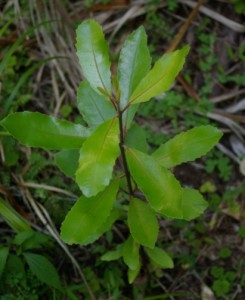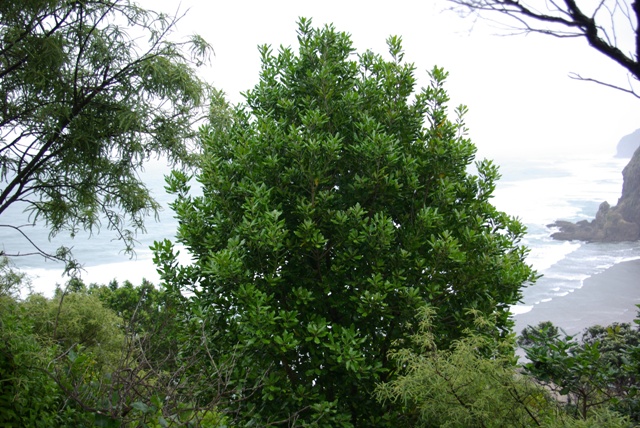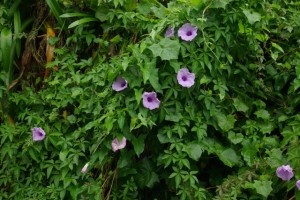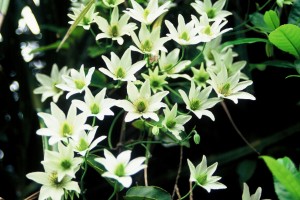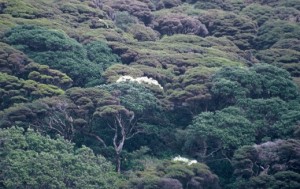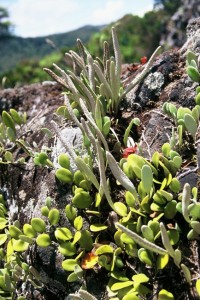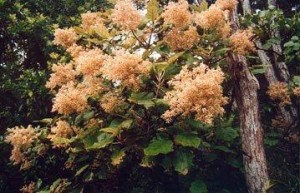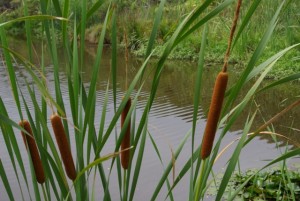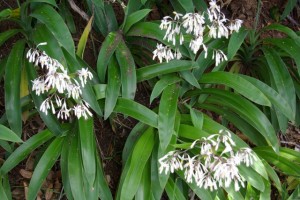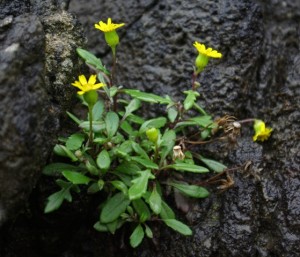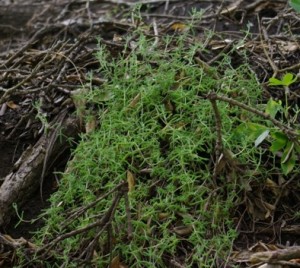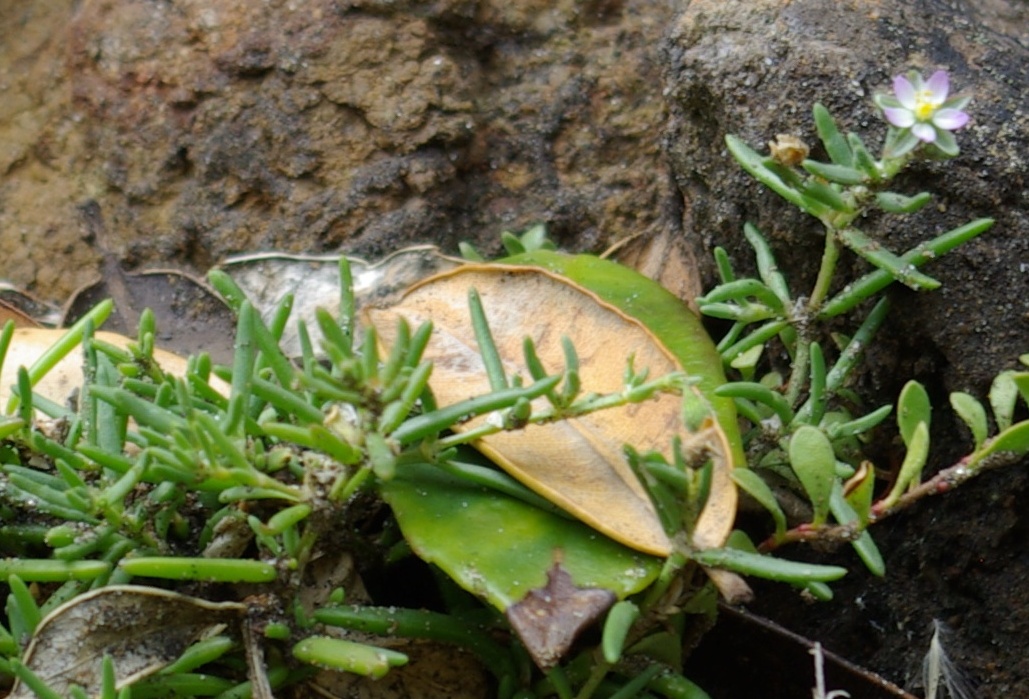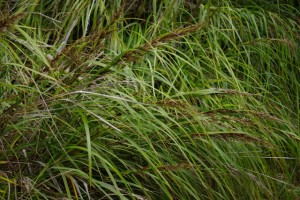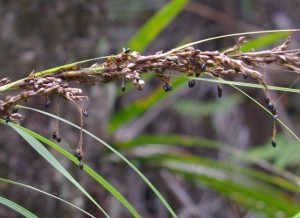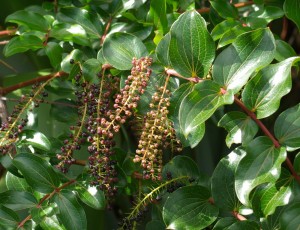Parataniwha
Elatostema rugosa family Urticaceae
Parataniwha is a handsome ground-cover plant with long oval ruby or purple-coloured leaves with prominent veins and a wrinkled surface. It likes shadey, damp areas in the forest and when it cloaks the forest floor or a ravine or rocky stream-side it produces a beautiful sight. While related to the nettle family, it is often described as a native begonia.
It is found only in the North Island and especially in the north of the island. It likes areas of falling water such as streams and waterfalls and can cloak the cliffs around a waterfall. It prefers to establish large colonies rather than small, single plants.
It is relatively common in the Waitakeres and there is a wonderful area that can be seen when travelling on the Rain Forest Express.
The woody stems spread along the forest floor and root into the ground. The flowers are small and insignificant and appear in spring/summer. It can be transplanted by taking a small rooted piece and potted up with peat and sand.
It is not to be confused with the plant pest Plectranthus which is a similar colour, likes a similar habitat, but has shorter oval leaves.
Peka-a-waka
Earina mucronata or epiphytic orchid
We came across this gorgeous orchid at the beginning of the Nikau Glade at the end of Garden Road. A spectacular sight, it was a like a huge yellow ball suspended high in a nikau. Unfortunately , this photo does not entirely do justice, as the myriad of flowers are delicate hanging clusters of green and orange set amongst elegant light green leaves. The flower stems can be 30cm to 1m long. They appear from October to November, though this photo was taken on New Years Day 2009.
There are about 120 types of native orchids, of which seven are epiphytes. They hang onto the trunks of trees by their roots. Stephen King says in Muriel Fisher’s book Growing New Zealand Plants, Tree and Shrubs, that they are not parasitic and do not harm the tree in any way. He says they are readily grown in thick slabs of tree fern fibre.
Apparently, Earina mucronata is reasonably common, but I had never seen one before. The flowers are perfumed, but this specimen was too far up the tree to test that out! Earina is found in New Zealand, New Caledonia, Fiji, Samoa and Tahiti.
Pingao or Golden Sand Sedge
Ficinia spiralis family Cyperaceae
When pingao first appeared at Piha in recent times it was as part of dune restoration. There was quite a negative reaction as the dunes created were steep as opposed to those where spinifex is the dominant plant, where the dunes are smoother. People said that pingao had never naturally grown at Piha but this was generally a product of the fact that the foredunes at Piha but were all but wiped out by the creation of roading and carparks at Piha in the 1960s. So people’s memories did not go back far enough to the time when pingao did indeed occur naturally on the Piha dunes.
The pingao at Piha is probably all planted. Pingao was once very common on sand dunes throughout New Zealand but in populated areas it has dwindled with the loss of sand dunes through competitionwith other dune plants such as marram, dune stabilisation programmes and trampling. Its threat status today is “relict” and it is gradually declining.
Pingao favours the front face of active unstable dunes and the faces of rear dunes provided there is wind-blown sand.
Pingao has stiff arching saw-edged leaves growing from thick rope-like rhizomes. The leaves are yellow-green when fresh and golden when dry. The clumps emerging from the rhizomes are more isolated than spinifex and it is therefore less effective at gathering sand.
The flowers appear in spring-summer and the dark red-brown seed heads appear in December to January.
Maori used the leaves of pingao for weaving the yellow sections of tukutuku panels inside meeting houses.
It can be grown from fresh seeds and cuttings.
Pohuehue
Muehlenbeckia complexa family Polygonaceae
This tangled sprawling vine loves sand dunes behind the foredunes where it forms spreading springy clumps, and competes with introduced kikuyu grass. It also likes scrambling over rocks and up low trees such as coastal manuka. The plant is drought-resistant and can become quite rampant in a garden setting, though I have seen it formed into wonderful hedges, even one with an archway through it at Karekare.
The stems are dark brown and wirey and the small light green heart-shaped leaves grow alternately on the stems.
Very small white flowers appear from late spring to summer that can be quite fragrant. They develop into small translucent fleshy cups bearing a single black seed. These appear concurrently with the flowers. These fleshy cups were apparently a food of Maori.
It is also well liked by caterpillars, butterflies and native moths, which lay their eggs in the stems.
Pohuehue will grow from seeds or cuttings and is one of a handful of plants that are favoured for dune revegetation. To grow pohuehue, gather the seeds in summer at the stage when they are in the translucent fleshy cups. Soak in water and then rub off the flesh. This is fiddly work, but you will be left with the tiny plack seeds like poppy seeds. Dry them and in spring put in a seed tray with a thin covering of seed-growing medium or sand.
Poroporokaiwhiri or Pigeonwood
Hedycarya arborea Family Monimiaceae
Porokaiwhiri is the only example of its family found in New Zealand, though there are about 30 genera scattered through the tropics. Pigeonwood was one of the first plants to be discovered by Banks and Solander at Tologa Bay in 1769.
Pigeonwood is an erect nicely shaped tree of the lowland forest that grows to about 12-16 metres. The smooth bark is quite dark, almost black, and the long shiny oval leaves are saw-toothed.
The male and female flowers are found on separate trees, with the female flowers smaller; the flowers are white-greenish, star-like and very fragrant; the berries that follow are bright orange-red and radiate out from the stem like the spokes of a wheel. They are very tasty for kereru, hence the European name. According to JT Salmon the kereru can consume large amounts and then become sleepy and slow-moving. The Greek word hedycarya means sweet-nutted.
Pouwhiwhi
Ipomoea cairica or Ipomoea palmata family Convolvaceae
I thought this plant an awful weed as it started to smother areas in Glen Esk Road – it looks very like the weed Blue Morning Glory. Indeed it is part of the same family but it is not a weed, but a very attractive indigenous plant.
It is common throughout the Pacific, eastern Australia and western Central America. It is relatively rare in New Zealand and tends to grow in remote northern coastal places such as the Three Kings Islands and the Kermadecs, but is found from Te Paki south to Tiritirimatangi in the Hauraki Gulf.
It has very long trailing creepers and in Glen Esk Road can be seen smothering rocky cliffs near the road and in drains and road margins. It has bright green leaves and handsome violet trumpet-shaped flowers with a dark throat. It has possibly been planted at Piha and escaped. In the photo the 5-leaved leaves are those of pouwhiwhi and the other leaves are the weed cape ivy.
It is inclined to be weedy and voracious as it is fast-growing and can sprout easily from stems, even cut ones. It can perform a useful function in smothering out other weeds in bare and disturbed land. It can be grown easily from cutting or seed but it sounds as if this would not be a good idea.
Puawananga, the sacred flower
Clematis paniculate
Clematis is one of the most beautiful and showy of the flowers of the New Zealand bush. It is a hardy, woody climber with large starry white flowers that grow in clusters of up to 100 or more blossoms which can smother tree crowns in the bush. Maori regarded the clematis as sacred, the child of Rehua (the star Anteres) and Puanga (the star Orion), and a harbinger of spring. The blossoms appear in October and November. In autumn the old flower heads are covered in attractive fluffy seeds.
Clematis can present a spectacular sight on the deep grey-green of the New Zealand bush. Driving along the Piha Road through the Waitakere Ranges parkland in October and November, the clematis are draped over the bush like votive garlands. It is hard to capture this with a camera, but the sight is truly one to gladden the heart.
The male and female flowers are found on different plants. The male flowers are the larger and showier. The flowers don’t have petals; what look like petals are sepals, part of the calyx of the flower. The plants can be grown from seed, or stem cuttings. When planting clematis, make sure their feet are in a cool, shady place.
There are 11 different types of clematis in New Zealand and they are found in lowland and subalpine forest, usually along the margins. Flowers on vines near the coast can be smaller than those found inland. The smaller clematis puataua (clematis forsteri) usually appears a little later than puawananga.
Clematis are part of the family ranunculaceae which includes buttercups and anemone. Ranunculaceae are found in temperate areas in all parts of the world. In many countries, clematis are brightly coloured, especially blue and violet. Robert Laing and Ellen Blackwell (Plants of New Zealand) suggest that the preponderance of white flowers in New Zealand is related to the paucity of insects. On the other hand we have a great number of night-flying moths and the authors argue that the flowers are white to attract insects at night.
Punakura or shore or wild lobelia
Lobelia anceps
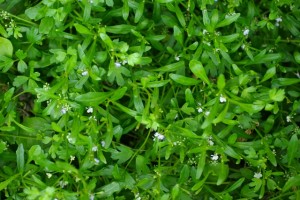 You have to get down onto your hands and knees to fully appreciate this diminutive creeping plant found on rocky and sandy shorelines. The leaves of punakura are oval and glossy green. The tiny delicate flowers which appear from November to March are blue when they first open but fade to white (as in the photo) or pale blue.
You have to get down onto your hands and knees to fully appreciate this diminutive creeping plant found on rocky and sandy shorelines. The leaves of punakura are oval and glossy green. The tiny delicate flowers which appear from November to March are blue when they first open but fade to white (as in the photo) or pale blue.
They are similar to a tiny orchid in shape or the more common bright blue garden lobelia used as a bedding plant or for edging. The anceps refers to the fact that the stems of this plant are grooved and angular, sometimes with tiny wings.
Pyrrosia eleagnifolia (previously P. serpens) Leather-leaf fern
Family Polypodiaceae
This odd-looking plant was photographed on a rocky bluff on the Piha Hill. It is actually a fern and is found in habitats from exposed coastal situations to lowland forests and is epiphytic on trees and rocks. Itis easily recognisable through its thick leathery undivided oval-shaped frond with the underside covered in brown hairs. Both the types of leaves shown in the photo are part of the same plant.
Because of its thick moisture-retaining leaves, P.eleagnifolia is a very tough and adaptable fern, that can survive in the toughest and driest of conditions. The brown spots on back of the thick leaves are spores and appear during the summer months.
According to the Firths in Ferns of New Zealand, it is easily propagated taking a section of rhizome and firmly attaching to the new host.
Rangiora
Brachyglottis repanda family compositae
Rangiora is a relatively common shrub or small tree (up to 7 metres) that grows in coastal scrub and lowland forest. It has large tough, wavy-margined leaves that are a dull grey-green above but are covered with white hairs (tomentum) on the underside. The brittle branches are also densely covered with white tomentum. After bruising, the leaves were used by the Maori and early settlers as a treatment for wounds and sores. The huge drooping panicles of creamy flowers are very showy and appear from August to November. They have a strong sweet scent. The flowers produce abundant nectar and attract insects and bees.
You can grow rangiora from cuttings or seed.
The rangiora likes sun and grows in open bush, bush margins and roadsides.
Raupo or bulrush
Typha orientalis
The native raupo is a handsome wetland plant found all over New Zealand in boggy places, lake edges and the like. At Piha it can be found alongside the Piha Stream, around the margins of the Lily Pond and in a small patch by a spring walking along the Tasman Lookout Track.
Obviously it likes wet feet, with water up to 1.5 metres in depth or water-logged soil. It has creeping underwater rhizomes that were known to Maori as korere and were eaten raw. The tall green sword-like leaves can grow to near 3 metres high though mostly they are under two metres. The flowers appear from December to March. The thick bottom part of the flower head is the female part, the thin spicky top part is the male part. The flower stalks are shorter than the leaves but they are very distinctive having a soft brown velvety appearance which darkens with age.
The seeds establish on the margins of waterways and invade deeper waters through the rhizomes. Plants can either be grown from seeds in a pot sitting under water, or by detaching a piece of rhizome with leaf attached and shifting to where you want to grow it.
Raupo is a water purifier and has a role in contorl of sediment and pollution. On the other hand it can become rampant and exclude other species especially in locations where it is being fed with nutrients from run-off.
As well as eating the rhizomes, Maori used dried raupo leaves for many purposes, including weaving, thatching and for bedding. The pollen was also collected and made into cakes. The raupo habitat also provided a food source, as it was the home of various wetland birds and eels. One of the main uses of leaves was for poi. For more on these weaving and leaf uses see the very informative website below.
http://www.landcareresearch.co.nz/research/biosystematics/plants/weaving/raupo.asp
Remuremu
Selliera radicans
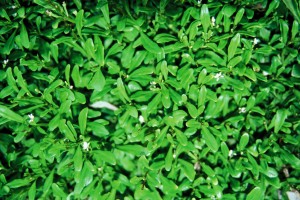 This bright green mat-like herb is found around sand dunes, especially wet, salt marshes, as well as on the banks of inland streams and lakes. This particular photograph was taken at the far end of North Piha beach where remuremu was growing at the back of dunes, close to the sea, alongside the native spinach, native celery and a fascinating variety of other small ground-hugging coastal plants.
This bright green mat-like herb is found around sand dunes, especially wet, salt marshes, as well as on the banks of inland streams and lakes. This particular photograph was taken at the far end of North Piha beach where remuremu was growing at the back of dunes, close to the sea, alongside the native spinach, native celery and a fascinating variety of other small ground-hugging coastal plants.
The plant is well-adapted to the salty conditions that it prefers. The saltier the surroundings the fleshier the mature leaves and the seeds can survive many months, even when they are in salty water. As remuremu is found in locations as far-flung as Australia and Chile, it is possible the seeds have travelled through the oceans driven by the prevailing westerly winds.
The tiny bright white flowers show up against the rich green of the leaves. They are lop-sided, or ˜half-flowers”, with five petals around a dark centre. They appear from November to April.
Rengarenga or Renga Lily
Arthropodium cirratum family Liliaceae
A prolific flowerer in early summer, the rengarenga has come into its own in recent years. It is now used widely in gardens and amenity planting in public places, people recognising its value as a low ground-cover and showy tropical looking plant. In urban areas it suffers from slug attacks which leave unsightly damage all over the leaves, but at Piha, in its natural setting, slugs are not an issue. You will find rengagrenga on any of the tracks up into the forest at Piha, and particularly on the Kitekite Falls Track where it crosses a rocky bluff near the falls.
Its natural habitat is on damp rocky ledges and stream edges in the under-storey of forest but it will prosper much more widely than that. It is particularly good for planting on banks and the edges of paths and driveways especially if there is shade.
There is a story behind the plants shown in the photo. About 30 years ago my mother took a few naturally occuring plants from the Moana Stream where it runs through our property, and potted them up and took them back to her home in Pt Chevalier. Over the years she used them to grow plants in her garden, and when her house was sold in 2003 I brought the potplant back to Piha. Its seeds were used to create many more plants which have been planted all over our property at Piha. So I like to think these are the longest journeyed rengarenga in New Zealand. They are doing a grand job of holding the banks in our driveway and providing a fine display when in flower.
The plant forms clumps and has large fleshy light green leaves about 30-60 cm long. In summer it produces many stalks with numerous branches with white flowers. It is the stamens of the plant that are the reason for its beauty. Laing and Blackwell say: “Seen under a magnifying glass they resemble small bottle-brushes, covered with organe or pink bristles”. The flowers are quite delicate-looking and a plant in full flower is a very pretty sight. After flowering seed capsules are formed and when these burst open it is easy to collect the numerous small black seeds.
These germinate readily in small pots and can then be planted out. The plant also self-seeds and thus clumps spread out and cover a wide area.
Senecio Lautus or Shore Groundsel
Family asteraceae
A dainty compact little annual plant that likes growing on rocks sprayed by the sea, like this one at Kohunui Bay at North Piha. It was sitting about 5 feet up on the cliffs facing seaward. The senecios are a large family and this is one of the commonest. Senecio lautus is a hardy plant that can vary in its features from place to place and can be found at heights up to 1500 metres.
The yellow flowers, born on slender stems, appear in November-March. When in flower, it makes an attractive picture on the cliffs faces amongst other herbs and small coastal plants.
It is easily grown from seed that can be gathered in late summer.
Spergularia tasmaninca or New Zealand sea spurrey
Family Caryophyllaceae
I found this tiny herb sprawling on the cliff faces at the back of The Gap. The flower was on a plant exposed to the elements, but the large bushy plant was found a little further back under pohutukawa.
It is found widely in New Zealand and Australia, hence the “Tasmania” in its name. It is so small and dainty it is easily missed.
The plants I photographed were clinging and sprawling on the cliffs, and the plant is highly tolerant to salt spray. Its leaves and stems are fleshy and succulent and although the plant sprawls, the ends of the stems are more erect and upward growing.
The flowers are born singly and are whitish with a mauve-blue flush on the tips of the petals. It is easily grown from seed, but then first you have to find your plant!
Tatangi
Gahnia lacera family Cyperaceae
One of the commonest and often overlooked plants of the Waitakere forest, especially coastal forest, is the sedge, gahnia lacera. Most of us notice it most when its barbed seeds painfully attach to the hairs on your legs or arms. But I have come to appreciate this inauspicious grass.
Gahnia lacera grows to only about 1m high and grows in tussock-like clumps on scrubland or open forest. It particularly likes disturbed land, and track edges where it has more light and becomes sparser in dense mature forest.
It flowers from July to November and the fruit are visible all year round.
Tatangi is actually quite hard to culivate. The seeds are difficult to germinate and the roots don’t like being disturbed so it can be hard to transplant from pot-grown plants. They often die in the attempt, however, tatangi self-proliferates readily. It is one of the first plants to appear where forest has been damaged by clearance or fire and as such serves a useful purpose as it softens the damage and suppresses the growth of pest plants.
The seeds of gahnia lacera are dark brown and held on erect stems, whereas the seeds of other forms of gahnia, which are usually larger in size, droop or hang down.
Other Maori names are Toetoe kiwi and Toetoe Mata.
Tutae koau or native celery
Apium prostratum
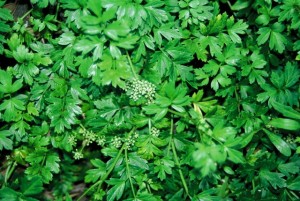 I first came across this plant at the far northern end of North Piha beach, growing on a sandy bank under pohutukawa just above the high tide mark. I have never seen it before so brought back a leaf specimen and found it in Andrew Crowe’s Which Coastal Plant? identified as the native celery. Laing and Blackwell call it˜prostrate parsley”, or, just to complicate the matter, ˜Maori celery” and Salmon calls it “wild celery” – apium australe.
I first came across this plant at the far northern end of North Piha beach, growing on a sandy bank under pohutukawa just above the high tide mark. I have never seen it before so brought back a leaf specimen and found it in Andrew Crowe’s Which Coastal Plant? identified as the native celery. Laing and Blackwell call it˜prostrate parsley”, or, just to complicate the matter, ˜Maori celery” and Salmon calls it “wild celery” – apium australe.
It does look like celery, parsley or angelica, as the glossy leaves are shaped like the leaves of these plants and they grow similarly on stems. The common garden celery belongs to the genus apium so is a cousin of tutae koau.
As indicated by the ˜prostratum” in its name, the native celery sprawls on banks and cliffs rather than growing upright. The location where I found it is typical (see photo). It was very close to the ocean, which it likes, the leaves being resistant to salt and wind. It was clambering over a sandy bank under mature pohutukawa. The flowers are small and white, born in clusters, as shown in the close-up photograph taken in January 2005. The flowers develop into small, oval, shining seeds which ripen from January to March.
The native celery has played an interesting role in Pakeha history as Cook used the gave it to his crews to ward off scurvy, a potentially fatal disease caused by a deficiency of Vit C. It was so effective that he used it for this purpose on all his voyages. Although it is edible, Maori used it for healing rather than as a regular part of the diet.
Tauhinu – cottonwood
Cassinia Fulvida or Ozothamnus leptophylla
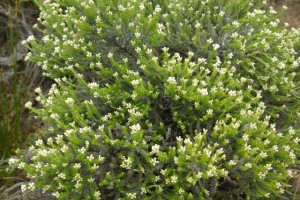 This plant was wrongly identified for me as pomaderris, but Ian Fox from Alter-Nursery & Landscaping in Whangarei (www.alter-natives.co.nz) put me straight.
This plant was wrongly identified for me as pomaderris, but Ian Fox from Alter-Nursery & Landscaping in Whangarei (www.alter-natives.co.nz) put me straight.
It is a heather-like shrub which appeared amid the gorse on our bush regeneration site. The bush is wiry, up to 1 metre tall, and the very small leaves have dense white hairs on the under-surface. It likes dry hills which is why it would be at home on our property and its doesn’t seem to mind strong wind and hot dry summers. The flowers appear in October and as can be seen in this photograph, smother the bush. It’s an impressive sight. We’re waiting for the seeds to have a try a growing some more.
I have one very large specimen of this which covers about nine square metres. It is quite prostrate with very thick, dark, tortured stems. Unfortunately the gorse loves to grow up through it which quite spoils the effect. However, I have lavished hours of care on it, crawling underneath to stump cut the gorse and paint with vigilant gel. It is repaying this care and growing into a luxuriant thick carpet, and a lovely sight.
Tauhinu seems immune to salty wind and grows very close to the sea at exposed, rocky sites such as Taitomo Island at Piha.
Tutu
Coriaria sarmentosa family Coriariaceae
One of New Zealand’s poisonous plants, the seeds and the leaves of the tutu being poisonous. Some of the animals liberated by Cook died from eating the leaves of tutu and settlers lost stock through feeding on tutu, called “toot-poisoning”. A Professor Easterfield and Mr Aston isolated the source of the poison in 1900 and published their findings. They had found a highly poisonous crystalline glucoside similar to that found in other bitter plants. They named the substance tutina.
At Piha, the main site for this shrub to be found is on the banks of the Piha Stream by the entrance to Piha Mill Camp. It sprawls over the banks, with long arching stems hanging over the waters of the creek.
The long stems have shiny opposite leaves, and the stems are noticeably four-angled.
The flowers appear September to October and are born on long dropping racemes up to a foot long. The profuse purple seeds are filled with purple juice.



